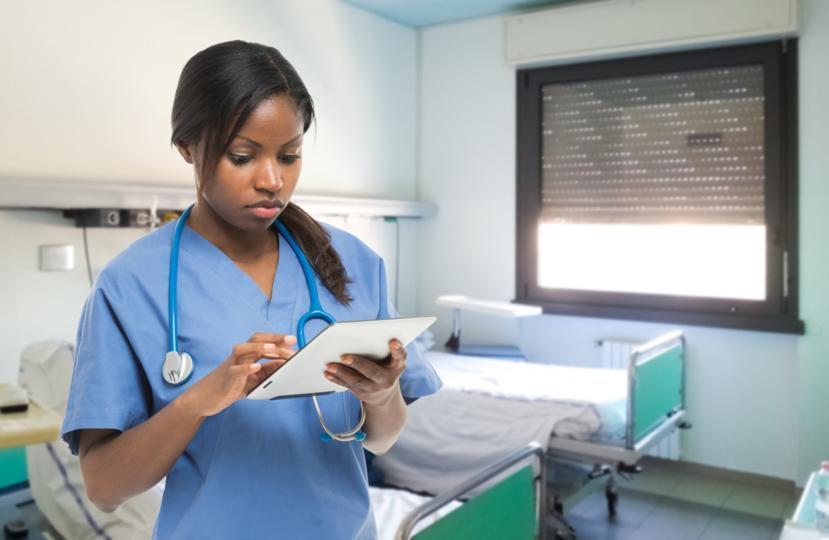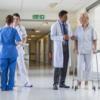What Handheld Devices Mean for Nursing

Society is fully enmeshed in the digital age. Eighty-six percent of adults between the ages of eighteen and thirty own a smartphone or tablet, compared to just seventy-eight percent of the same age group that own laptops. There’s no denying that smartphones with their plethora of apps aid us in sharing everything from photos to breaking news. Technology is in almost every facet of our lives helping to make it easier and more manageable, so it’s no surprise that eventually handheld devices would make their way into the medical field.
How Handhelds are Used in a Medical Setting
One of the lures of handheld devices is in the ease of carry, mostly used by nurses who have more direct sustained patient contact, some hospitals saw a decline in mortality rates when they were able to quickly call up a patient chart from a handheld device within reach. The handheld devices used in a hospitals are not off the shelf devices, these are come preloaded with software relevant to the hospital where they will be used and are networked so that anyone with the authorization can see patient information.
An Enhancement in Patient Care
Of the many things that handhelds can do for the professionals that use them, the biggest benefit is the boost it offers in patient care. With the devices, nurses can record and monitor, blood pressure, heart rate, oxygen levels and pulse. The stats are then uploaded to the networked system where it can be accessed quickly in emergency. One hospital saw a drop in fatalities of four hundred patients at the end of the first year after handhelds were introduced, the key reason is that nurses were able to quickly assess deterioration in patients and react immediately.
Handhelds are being found to more often improve the accuracy and even the completeness of patient care and documentation. Because health care providers can now more easily cross reference their patients medications with interactions and side effects, they can give more detail to the patient when having discussions about new medications, or a new course of treatment. This approach also puts more power in the hands of the patients, who can now make a more informed decision due to having more information. A study showed that patient charts and clinical documentation done with a handheld to be more accurate and offered a significant decrease in prescription errors than when paper charts were used. The same study found that the use of the Universal Protocol checklist went up significantly as well in facilities that utilized handhelds and that the discharge portion of the checklist order errors.
Medication Error Prevention
It’s also easier to take notes and record notes on a handheld device rather than a paper chart, there’s also no fear that the chart will be lost or that instructions are unreadable due to handwriting, it cuts down on the possible amount of mistakes by eliminating most of the human error. Patients charts can be quickly checked to see what medications they’re currently taking as well as any allergies or potential drug interactions. Many hospitals and medical centers employ decision support system (DSS) handheld apps that are used to not only monitor prescriptions and medication lists of patients, but strive to eliminate or cut down on unnecessary or unsafe prescribing, as well as keeping staff up to date on all medication shortages.
Rapid Diagnostics and Consults
In emergency rooms where split second decisions can mean the literal difference between life and death, studies that found that being able to rapidly upload and disseminate not only updated charts but body scans and EEG’s enabled emergency physicians make better decisions in a more timely fashion. It also enabled them to send directly to the devices of the nurses working on the teams of specialists that they needed consults on. The consulting physician being able to respond more accurately by being able to have access to all the materials he needed.
Faster Communication
A study conducted over a six week period tested call response times for physicians that had a handheld with mobile phone features versus those that has to use conventional methods such as finding a phone to respond to a page or a pager. The study showed that physicians with handhelds consistently responded faster and failure to respond incidences were lower. The idea being that a physician with all the tools for communication at his disposal would will be more willing to respond as it streamlines their work practices, since they most likely won't have to stop and search for a method of responding to a call or depending on someone else to return the page for them.
Handhelds Benefit Medical Professionals Personally
All of the handhelds currently used in facilities are part of a networked system, as such when they are used, they need to be signed into and also out to keep track of who is using it and when they are using it. While most of the time the devices are being used for things that are related to patient care, there have also cropped up a number of apps that seek to keep professionals up to date on their certifications and training. For nurses in particular, there a quite a few apps that are designed to help nurses study for and pass exams and are also great resource repositories.
Mobile devices are in every part of the educational system, so it’s no wonder that medical students are also taking advantage of having a pocket brain to keep up with studies and resources as technology has taken on a major role in medical education where more and more classes are employing technology during training . Students utilise any number of apps to not only study, but to perform complex calculations, take notes or keep logs of rotations and schedules and to access medical information and treatment strategies.
In addition to the handheld devices and apps, many medical textbooks are available in electronic formats which are easier for students to access if they can keep all on the same device, and cost a fraction of traditional bound textbooks. The ability to access all these electronic resources has been shown to have a marked increase in student knowledge and the learning environment.
Looking Ahead
It would be easy to say that all this technological prowess is the wave of the future, but it’s not without it’s pitfalls. I can become too easy to depend on something that sits safely in a pocket just waiting to be brought out at the moment that it’s needed, but the thing to remember that it can only be good as the person that programmed it and as simple a thing as a power outage ay find a facility at a loss without all it’s information. While technology is great, it’s no substitute for a person that has the knowledge to treat a patient on the fly.
That being said the world will only get more technologically advanced, the medical field would do well to stay on top of these advancements as for the most part it can only benefit from them. When used in conjunction with well trained healthcare professionals, There is nothing to fear from having technology in the field of medicine.















